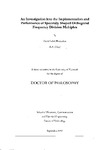An Investigation into the Implementation and Performance of Spectrally Shaped Orthogonal Frequency Division Multiplex
| dc.contributor.author | Bhatoolaul, David Lahiri | |
| dc.contributor.other | School of Engineering, Computing and Mathematics | en_US |
| dc.date.accessioned | 2013-10-23T09:42:54Z | |
| dc.date.available | 2013-10-23T09:42:54Z | |
| dc.date.issued | 1999 | |
| dc.identifier | NOT AVAILABLE | en_US |
| dc.identifier.uri | http://hdl.handle.net/10026.1/2306 | |
| dc.description.abstract |
Orthogonal Frequency Division Multiplex (OFDM) is a flexible, robust multi-carrier modulation scheme. The orthogonal spectral shaping and spacing of OFDM sub-carriers ensure that their spectra can be over-lapped without leading to undesirable inter-carrier interference. Conventional OFDM systems have non-band limited Sinc(x) shaped subcarrier spectra. An alternative form of OFDM, referred to hereafter as Spectrally Shaped OFDM, employs band limited Nyquist shaped sub-carrier spectra. The research described in this thesis investigates the strengths and weaknesses of Spectrally Shaped OFDM as a potential modulation scheme for future mobile radio applications. From this research a novel Digital Signal Processing architecture for modulating and demodulating Spectrally Shaped OFDM sub-carriers has been derived which exploits the combination of a complex Discrete Fourier Transform (DFT) and PolyPhase Network (PPN) filter. This architecture is shown to significantly reduce the minimum number of computations required per symbol compared to previous designs. Using a custom coded computer simulation, the effects of varying the key parameters of the novel architecture's PolyPhase Filter (PPN) filter an the overall system complexity, spectral performance and system signal-to-distortion have been extensively studied. From these studies it is shown that compared to similar conventional OFDM systems, Spectrally Shaped OFDM systems possess superior out-of-band spectral qualities but significantly worse Peak-to-Average-Power-Ratio (PAPR) envelope performance. lt is also shown that the absolute value of the end PPN filter coefficients (dependent on the roll-off factor of the sub-carrier spectral shaping) dictate the system signal-to-distortion ratio when no time-domain windowing of the PPN filter coefficients is applied. Finally the effects of a both time and frequency selective fast fading channels on the modulation scheme's uncoded Bit Error Rate (BER) versus Signal-to-Noise (SNR) performance are simulated. The results obtained indicate that Spectrally Shaped OFDM is more robust (lower BER) to frequency-selective fading than time-selective fading. | en_US |
| dc.language.iso | en | en_US |
| dc.publisher | University of Plymouth | en_US |
| dc.title | An Investigation into the Implementation and Performance of Spectrally Shaped Orthogonal Frequency Division Multiplex | en_US |
| dc.type | Thesis | |
| dc.identifier.doi | http://dx.doi.org/10.24382/3856 | |
| dc.identifier.doi | http://dx.doi.org/10.24382/3856 |
Files in this item
This item appears in the following Collection(s)
-
01 Research Theses Main Collection
Research Theses Main


